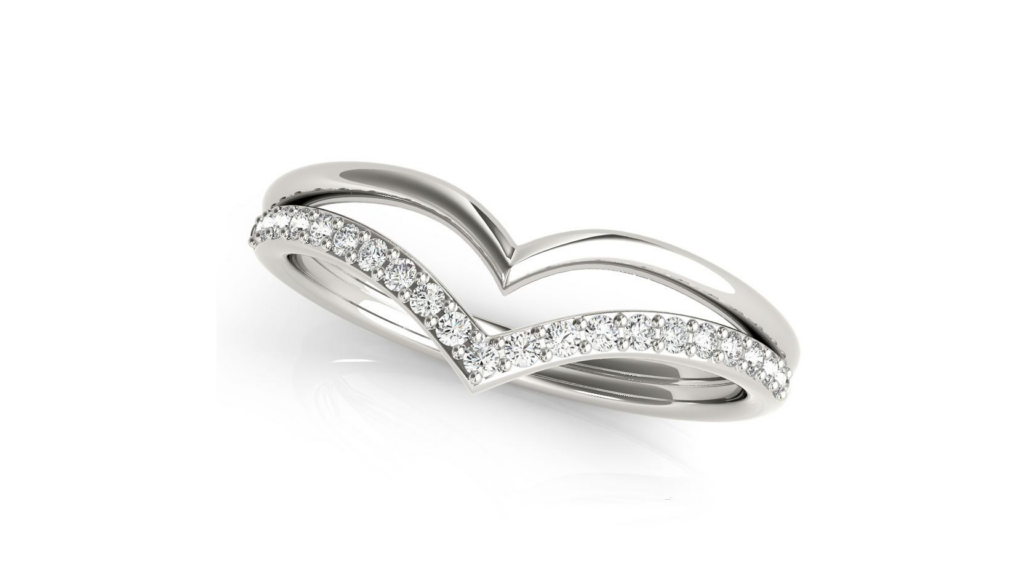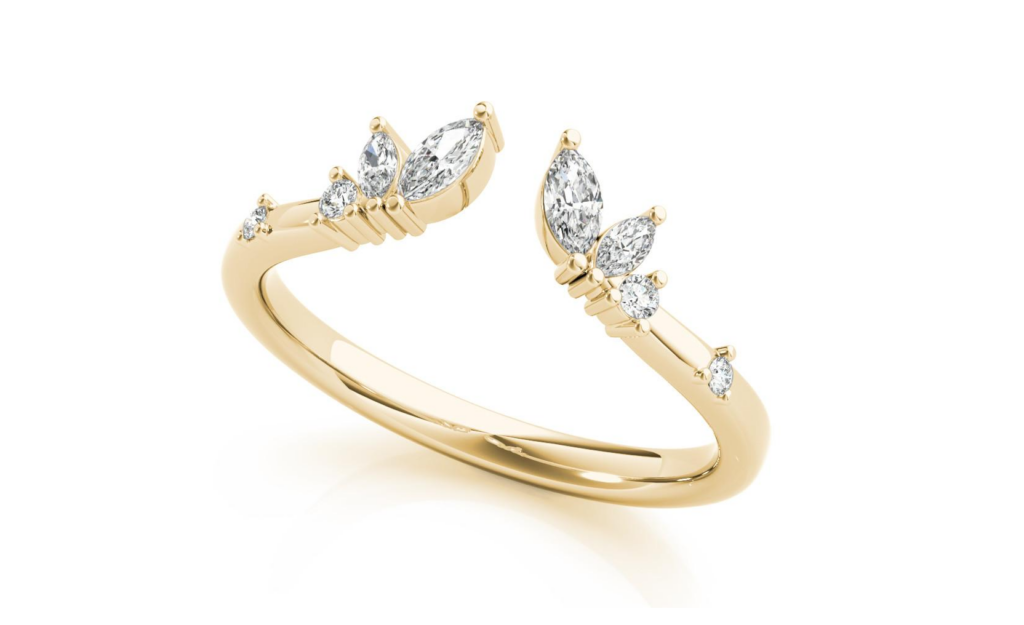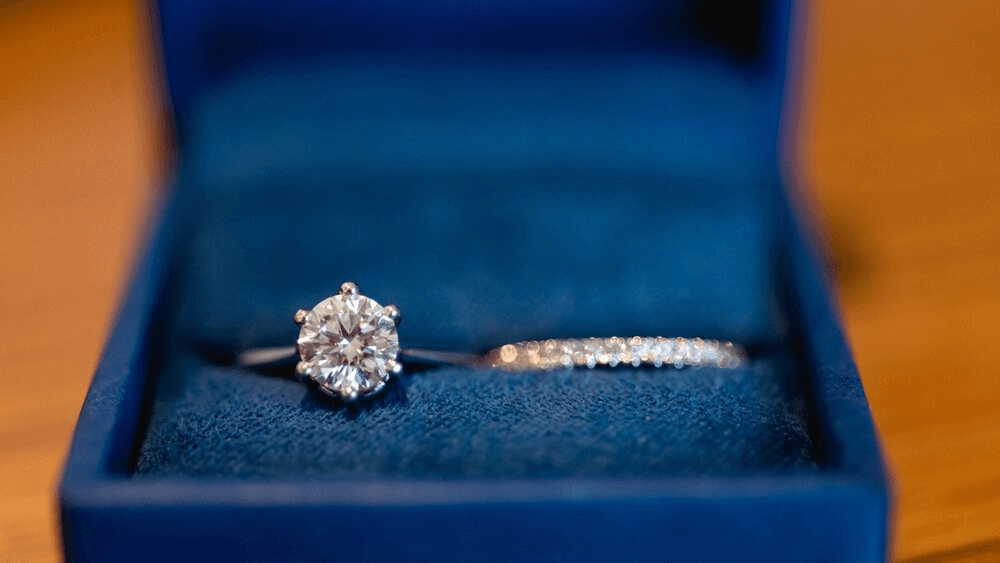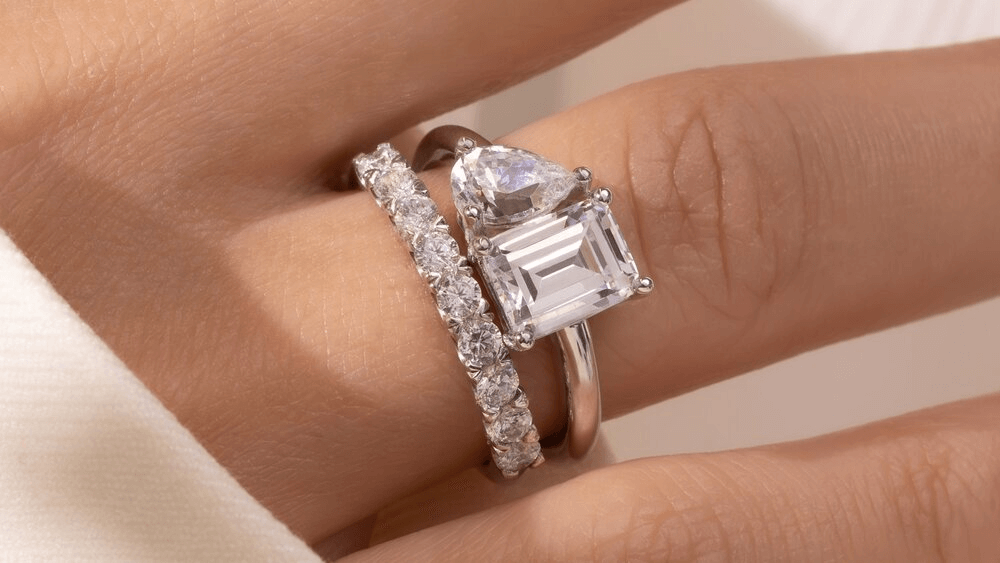5 Reasons Chevron Wedding Band Rings Are Taking Over

By Gary A.

Edited by Olivia H.
Published Aug 8, 2024
Edited on Mar 31, 2025
Chevron wedding rings are a modern twist on tradition, offering a unique V-shaped design that adds both elegance and versatility to your bridal set- discover why chevron wedding rings are more than just a trend in our complete guide.

Navigate This Guide:
- 7 Quick Tips for Choosing Your Chevron Wedding Band
- Introduction to Chevron Wedding Rings
- Why Choose a Chevron?
- The Artistry Behind Chevron Designs
- Our Expert Take
- 9 Frequently Asked Questions about Chevron Wedding Rings
Before we dive deeper into the specifics, here are some practical tips to help guide your decision-making process:
7 Quick Tips for Choosing Your Chevron Wedding Band
- Tip 1: Understand the Chevron Design:
- The Chevron design, also known as the wishbone or V-shaped design, is unique and can vary in depth and curve. Decide whether you want a pronounced V-shape or a more subtle curve. This design should complement the main stone of the engagement ring, so ensure that the V-shape accommodates the size and shape of your chosen gemstone.
- Tip 2: Ring Material & Durability:
- The material of the ring plays a significant role in its durability. Platinum and 18-carat gold (whether white, yellow, or rose) are more durable and suitable for everyday wear. Ensure the material matches or complements any existing jewelry, especially if you plan to wear the engagement ring alongside other rings.
- Tip 3: Stone Setting & Security:
- Examine how the stone is set in the Chevron design. Common settings include prong, bezel, and channel. Ensure that the setting securely holds the stone, especially in a V-shaped design where the stone might be more exposed.
- Tip 4: Customization & Fit:
- Given the unique shape of Chevron rings, it might be worth considering a custom design to ensure a perfect fit with the engagement stone. If pairing with a wedding band, consider how the two rings will fit together. Some people opt for a Chevron wedding band that nests perfectly with the engagement ring.
- Tip 5: Check the Return & Warranty Policy:
- Always ensure that the jeweler offers a good return policy and warranty. Given the unique design of Chevron rings, you might change your mind upon seeing it in person or wearing it for a few days. A warranty is also essential to cover any potential damages or issues with the setting over time.
- Tip 6: Budget & Hidden Costs:
- Set a clear budget for the engagement ring. Remember, the Chevron design might come with additional costs, especially if opting for a custom design or a ring with multiple stones. Always ask for a detailed price breakdown to avoid any hidden costs.
- Tip 7: Certifications & Authenticity:
- Ensure that the gemstone, especially if it’s a diamond, comes with a certification from a recognized gemological institute. This certification will provide details about the stone’s cut, clarity, color, and carat weight. It’s a guarantee of the stone’s quality and authenticity.
Now that you’ve got these practical tips, use Jeweler AI below to find the perfect engagement ring that suits your style and budget:
Introduction to Chevron Wedding Rings
Chevron wedding bands combine the very tradition with something a little more modern…
A straight, solid band of gold or platinum is the obvious choice for a wedding band, whether you are a bride or a groom, traditional or out there. It’s one of those things that tends to defy the trend cycles. While big, puffy wedding dresses have been relegated to the 1980s and ‘burlap ‘n’ gingham’ weddings to the 2010s, the traditional wedding band stands the test of time.
But does that mean it’s your only option? Absolutely not. True, it’s the obvious choice, but there are plenty of reasons why you might want to go for a different shape. Some of them have to do with aesthetics and style, others have to do with comfort and wearability.
This is really where the Chevron ring comes into things. As far as wedding bands go, it’s got a lot going for it…
Defining the Chevron Wedding Band
As you might have guessed from the name, chevron wedding bands feature a v-shape. While the traditional wedding gowns we mentioned above enwrap the finger in a straight line, chevrons feature… well, a chevron.
Typically, you’ll see this feature on women’s wedding bands, although some men do choose to adopt the feature into their own wedding band design as well. It has an edgy, modern look that some grooms love.
Most people choose to wear the ring so that the chevron is pointing towards the base of their finger – in other words, point down – but, inverted, the design almost mimics the shape of a crown or tiara.
Symbolism and Tradition: The Wishbone Connection
However, whatever way you wear it, the resemblance to a wishbone is hard to deny. Whether you find that romantic, or whether it evokes memories of Thanksgiving dinners when all you wished for was an antacid, is down to you…
The sharpened point can also be seen as a representation of two parts meeting. The usual wedding band design is meant to evoke a continuous, unbroken loop – AKA, your love for one another – but the idea of two ends coming together it’s just as romantic when you think about it.
From that sharpened point, the two sides of the band reach out in a very elegant sweeping shape – like the spread of a bird’s wings.
A beautiful shape with a lot of symbolism behind it.
Why Choose a Chevron?
Although the beauty and elegance of the Chevron wedding band speaks for itself, arguably the most compelling reason to choose one for your wedding band is its versatility when it comes to fitting around an engagement ring.
A lot of engagement rings, particularly those that are set lower, take up more space than the band itself. For instance, if you’ve got a simple halo engagement ring, the halo will overhang the edges of the band by a few millimetres on each side. This is one of the more extreme examples, but even a simple solitaire can have the same effect if it’s set low enough to the band.
Then, if you’ve got any decorative elements on the ring shoulders, you’ve also got those to contend with.
What this can mean is that wearing a traditional, straight wedding band winds up being a little uncomfortable. The silhouette of the engagement ring isn’t necessarily a straight line, so there will be gapping and pinching between the two bands after the wedding. This isn’t obvious straight away, when the bride is only wearing the engagement ring, but it can become a source of annoyance pretty fast.
It is possible to have a bridal set designed whereby the wedding band is contoured carefully around the silhouette of the engagement ring but, in a lot of cases, a chevron band is enough. It can make wearing the two rings at the same time a lot more comfortable.

The Artistry Behind Chevron Designs
While the shape looks simple enough, it takes a lot of skill to make a Chevron ring look balanced, proportioned, and symmetrical. Any slight mistake from the jeweler, and everything will be thrown off balance.
There are so many ways to decorate a chevron, and many of them will be familiar to you if you’ve already done your research on…
From Minimalist to Elaborate
A plain wedding band is beautiful in its own way, so don’t be afraid to leave your chevron ring unadorned.
The other popular choices to go for a pavé setting, which will add extra sparkle to the bridal set. Alternatively, integrate a split shank into the design and set one ‘strand’ of the ring with pavé while leaving the other plain.
Jewelers can also integrate design elements like accent stones, milgrain, and filigree into the ring, and that can really enhance the sweeping silhouette of the chevron, too.
If you really want to buck the trends, consider completely leaving the tip of the chevron open. The result can feel very organic and beautiful…

Material Matters: Gold, Platinum, and Diamonds
As always, focus on matching your choice of medical to the engagement ring, if you can. Obviously, this rule doesn’t need to apply if your bride likes to mix metals, but most of us have a preference one way or the other. If the engagement ring it features one metal, and the wedding band features another, things can look a little uncoordinated.
Chevron wedding bands are strong, so don’t worry too much about going for higher karat just because the design is different. Anything up to 18K will be perfectly fine for a wedding band, although a lower karat type like 14K will be less vulnerable to surface scratches.
Our Expert Take
Chevron rings are great. They’re beautiful and elegant in their own right, but they also serve a practical purpose that can really streamline and enhance the wearability of a bridal set. They’re an excellent choice, even if they do ‘break the mold’ a little when it comes to the symbolism of the solid, straight wedding band.
It’s probably a good idea to talk things through with your partner when it comes to the chevron. They’re becoming increasingly commonplace and gaining a lot of popularity these days but, since old habits die hard, it’s always worth that conversation.
9 Frequently Asked Questions about Chevron Wedding Rings
- Q: What is a Chevron Wedding Ring?
- A: A Chevron wedding ring features a V-shaped design, inspired by the wishbone, symbolizing luck and good fortune. It’s known for its unique shape that complements many engagement ring styles.
- Q: How do you wear a Chevron Wedding Ring with an Engagement Ring?
- A: Typically, the Chevron wedding ring is worn on the same finger as the engagement ring, with the V-shape pointing towards the wrist, allowing the engagement ring to nestle within its curve.
- Q: Can Chevron Wedding Rings be customized?
- A: Yes, Chevron wedding rings can be customized in terms of metal, design depth, and gemstone settings to match personal preferences and engagement ring styles.
- Q: Are Chevron Rings suitable for daily wear?
- A: Yes, when made from durable materials like platinum or 18-carat gold, Chevron rings are suitable for daily wear. The choice of material and design affects their longevity and comfort.
- Q: What types of gemstones can be set in a Chevron Wedding Ring?
- A: Chevron rings can feature a variety of gemstones, including diamonds, sapphires, rubies, and more, depending on personal preference and budget.
- Q: Can Chevron Wedding Bands be worn alone?
- A: Absolutely, Chevron wedding bands have a distinct and modern aesthetic that allows them to be worn alone as a stylish statement piece.
- Q: How do I choose the right Chevron Wedding Ring?
- A: Consider the engagement ring’s style, the desired material, and the fit between the two rings. It may also be helpful to try on different Chevron designs to see which complements your engagement ring best.
- Q: Do Chevron Wedding Rings come in different metals?
- A: Yes, Chevron wedding rings are available in a range of metals, including yellow gold, white gold, rose gold, and platinum, catering to various tastes and preferences.
- Q: How should I care for my Chevron Wedding Ring?
- A: Regular cleaning with mild soap and water, avoiding harsh chemicals, and removing the ring during strenuous activities can help maintain its beauty. Annual check-ups with a jeweler are also recommended.
- Q: Are Chevron Wedding Rings more expensive than traditional bands?
- A: The price can vary based on design complexity, materials, and gemstones used. Chevron rings can be comparable in price to traditional bands, especially when opting for simple designs.
Find your perfect Chevron ring with Jeweler AI – where tradition meets precision.
FOLLOW-UP GUIDE SERIES






